Being a representative of Farmers Organisations (FOs) in Southern Africa, I find the topic “Making the farmers voice heard” both interesting and challenging. My opinion is that the strengthening of the farmers’ voice is absolute necessary and fundamental for the achievement of agriculture development and a green revolution in Africa. It was therefore most encouraging that almost all working groups in the “Towards an African Green Revolution Conference and Seminar” made recommendations on the need for strengthening of the capacity of FOs.
A number of good recommendations were presented by the different working groups in the conference/ seminar. However, I believe that the role that FOs should play in making the farmers’ voices heard did not come out clearly in the discussions. I have therefore made an attempt in this submission to outline some of the key-roles that are important for FOs to perform in order to create a better understanding for the support that they are in need of. I have focused my discussion on two key areas which are both crucial for strengthening of the voice of farmers. The first area focuses on the role FOs should play in order to influence agricultural policies and programmes. The second area focus on the role FOs should play in order to achieve a more equal power balance between smallholder farmers and agribusinesses. I have finally made an attempt to discuss: What should be done to enable FOs to play their roles?
What role should FOs play to increase smallholder farmers’ influence on agricultural policies and programmes?
Smallholder farmers’ influence on agricultural policies and programmes is generally week. Most organizations representing smallholder farmers lack or has limited capacity to effectively engage in different policy formulation processes. Because of their limited capacity, FO’s have had a tendency to be more reactive than proactive in the policy formulation process and have often entered the process at a late stage when it is difficult to influence the decisions. As a result, they have had little influence on agricultural policies.
To become more influential, there is need to strengthen the capacity of National Farmers Unions to:
a) Identify the critical policy issues and to develop their own policy agenda.
b) Analyse the issues through farmer lead policy research.
c) Formulate policy proposals/ positions through consultative processes with their members. This is important in order to create ownership of the policy positions and to enable their representatives to lobby for their positions with strength.
d) Engage in effective advocacy and lobbying with the decision makers. This includes formation of networks and alliances for their positions/ proposals, development of effective lobby strategies, etc.
e) Communicate their positions, objectives and achievements with their members, stake holders and general public.
What role should FOs play strengthen smallholder farmers marketing powers?
Smallholder farmers’ power balance with agribusinesses is also generally weak. Studies have shown that the power balance between farmers and agribusinesses is heavily tilted in favour of the agribusinesses. Unequal power balance has resulted in smallholder farmers not being able to get a fair price for their products in relation to other actors in the value chain.
To achieve more equal partnerships that enable mutual growth and fair deals between smallholder farmers and agribusinesses, there is need to develop and strengthen the capacity of Commodity Organisations and national Farmers Unions to:
a) Provide information to their members about marketing opportunities, producer prices, etc. and to link up farmers with agribusinesses willing to buy their products,
b) Analyse value chains, and develop marketing strategies and member services that are relevant to the members needs.
c) Engage in collective negotiations with agribusinesses about contracts in contract farming arrangements
d) Monitor implementation of contract arrangements,
e) Provide advisory service and farmers’ skills development on production techniques, standards, marketing, etc.,
f) Develop, promote and organise appropriate bulk input and output marketing systems for members including auctioning, warehouse receipt systems, brokerage, etc.
g) Promote establishment of appropriate agribusinesses such as farmers’ cooperatives,
What should be done to enable FOs to play their roles?
To perform the above roles, national FOs will be in need of training, advisory service and technical backstopping support. Such support could be provided for by various specialised organisations in different subject matters. E.g. policy research institutions could be assigned by FOs to carry out policy analysis. Other institutions could carry out training on lobby and advocacy, etc. This type of technical support could be coordinated by the Regional FOs. E.g. SACAU is already providing and coordinating capacity building support to its member organisations (National Farmers Unions) in Southern Africa. However, the ability to provide such services will depend on the availability of financial resources.
Simultaneously, the national FOs themselves will be in need of financial resources to perform their activities. This includes to employing specialists; to pay for office space and equipment; and to pay costs for implementation of different activities.
A common problem is that most FOs representing smallholder farmers are unable to generate such financial resources from their members. The main reason is that the farmers they represent are poor and the FOs has to put their membership fees at such low levels that are affordable to the poor farmers but not sustainable for their organisations.
For most smallholders FOs, the main source of income has been financial support from various development and donor agencies. Such support has mainly enabled FOs to maintain core functions of their organisations. Few organisations have received financial support that has enabled them to significantly strengthen the voice of the smallholder farmers.
Although desirable, it is not realistic to believe that national FOs, in particular Farmers Unions representing smallholder farmers, will be in a position, at least in the short to medium term, to generate adequate funds from their members. They will remain in need of financial support from development and donor agencies. It will therefore be important that those agencies not only maintain their support but significantly increase their support to FOs.
To make donor support more efficient, there is need for increased donor coordination and a shift from project to programme support along the lines of the Paris declaration. Such programmes should be planned for by the FOs themselves and should outline the role they should play, backstopping support that they would be in need of, capacities that they would require and gaps that needs to be filled, with focus on achieving agriculture development in Africa. An important part in their planning should be to address gender issues, and specific interests expressed by women and poor farmers.
National programmes could be integrated into regional programmes and support to the national FOs could be channelled through the regional FOs. The idea of the establishment of an African-wide, farmer-owned and farmer-driven fund for directing research, innovation and technology development toward farmers needs, should be broadened and should include institutional capacity building of national and regional FOs to perform services that enables the achievement of a uniquely Green Revolution in Africa.

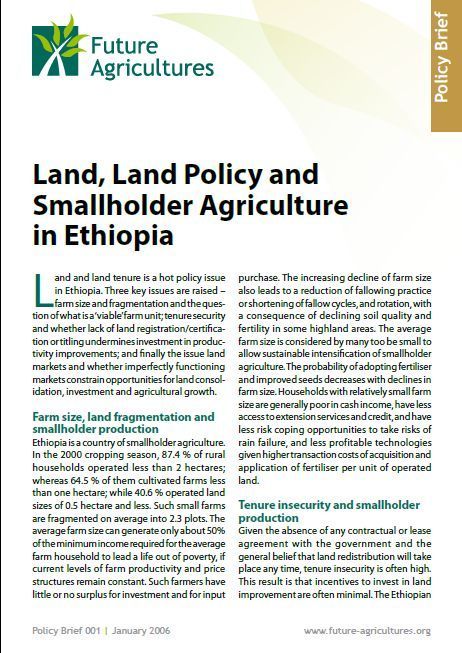 Land and land tenure is a hot policy issue in Ethiopia. Three key issues are raised – farm size and fragmentation and the question of what is a ‘viable’ farm unit; tenure security and whether lack of land registration/certification or titling undermines investment in productivity improvements; and finally the issue land markets and whether imperfectly functioning markets constrain opportunities for land consolidation, investment and agricultural growth.{jcomments off}
Land and land tenure is a hot policy issue in Ethiopia. Three key issues are raised – farm size and fragmentation and the question of what is a ‘viable’ farm unit; tenure security and whether lack of land registration/certification or titling undermines investment in productivity improvements; and finally the issue land markets and whether imperfectly functioning markets constrain opportunities for land consolidation, investment and agricultural growth.{jcomments off}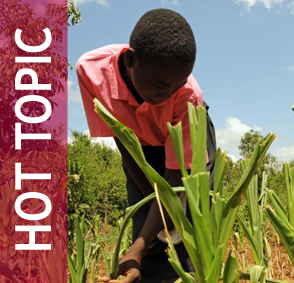 The economic, social and cultural contexts of agriculture are changing fast, as evidenced by significant shifts in the patterns of food production and consumption. An increasingly globalised world also means that there is now greater access to fast-evolving communication and media technology, which improves information flows and adds to the feeling that the world is getting smaller. However, development and growth processes still move at different speeds in different locations, even within countries.These inequalities are increasingly visible to people living in remote rural areas, often characterised by under-investment and slow growth.
The economic, social and cultural contexts of agriculture are changing fast, as evidenced by significant shifts in the patterns of food production and consumption. An increasingly globalised world also means that there is now greater access to fast-evolving communication and media technology, which improves information flows and adds to the feeling that the world is getting smaller. However, development and growth processes still move at different speeds in different locations, even within countries.These inequalities are increasingly visible to people living in remote rural areas, often characterised by under-investment and slow growth.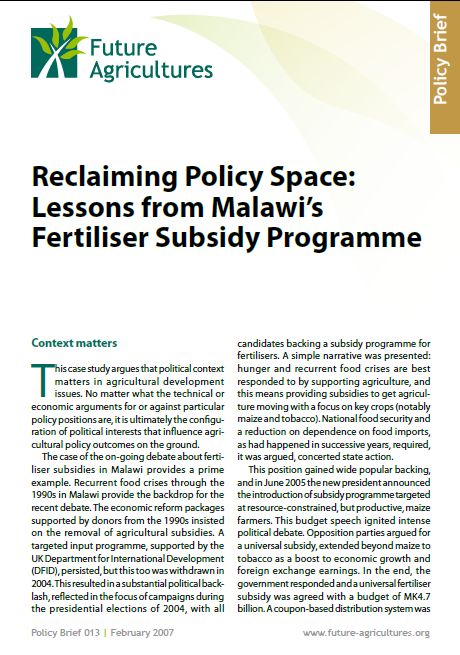 This case study argues that political context matters in agricultural development issues. No matter what the technical or economic arguments for or against particular policy positions are, it is ultimately the configuration of political interests that influence agricultural policy outcomes on the ground.
This case study argues that political context matters in agricultural development issues. No matter what the technical or economic arguments for or against particular policy positions are, it is ultimately the configuration of political interests that influence agricultural policy outcomes on the ground.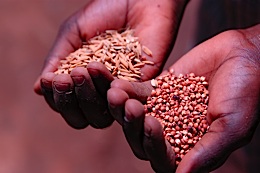 By Lucas Barasa*
By Lucas Barasa* On November 30 in Nairobi, more than 160 delegates from across Africa met for the fourth CAADP Africa Forum, organized by the New Partnership for Africa’s Development (NEPAD) from 30 November-4 December 2009. The Forum’s theme is ‘The Bottom of the Pyramid: Agricultural Development for the Vulnerable’.
On November 30 in Nairobi, more than 160 delegates from across Africa met for the fourth CAADP Africa Forum, organized by the New Partnership for Africa’s Development (NEPAD) from 30 November-4 December 2009. The Forum’s theme is ‘The Bottom of the Pyramid: Agricultural Development for the Vulnerable’. A major conference to help enhance food security in Africa and share lessons on best practices took place in Nairobi from 28 – 30 November 2009.
A major conference to help enhance food security in Africa and share lessons on best practices took place in Nairobi from 28 – 30 November 2009. 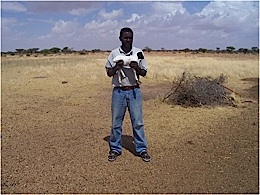
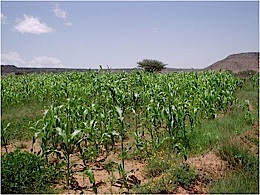 Towards a “Green Revolution” for Africa How can Africa’s farmers, scientists, development practitioners, private entrepreneurs and public officials spark a “uniquely” Green Revolution in Africa, one that responds to the region’s unique social, political and ecological conditions?
Towards a “Green Revolution” for Africa How can Africa’s farmers, scientists, development practitioners, private entrepreneurs and public officials spark a “uniquely” Green Revolution in Africa, one that responds to the region’s unique social, political and ecological conditions?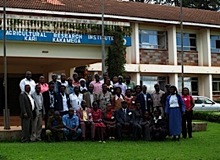 From October to November 2009 The Future Agricultures Consortium (FAC) in partnership with the
From October to November 2009 The Future Agricultures Consortium (FAC) in partnership with the 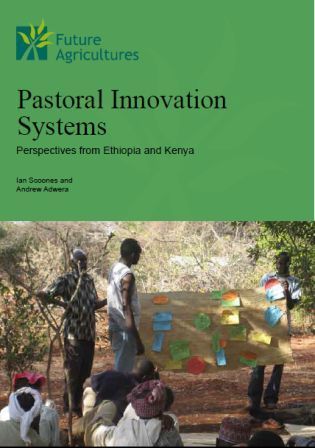 This project aims to generate debate about pastoral innovation options, focusing on pastoral areas of Kenya and Ethiopia, linking insights from pastoral areas to the wider debate about science and technology in Africa.
This project aims to generate debate about pastoral innovation options, focusing on pastoral areas of Kenya and Ethiopia, linking insights from pastoral areas to the wider debate about science and technology in Africa.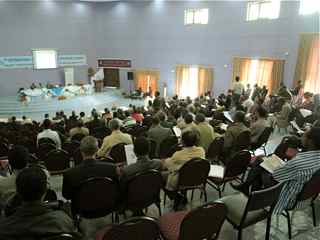
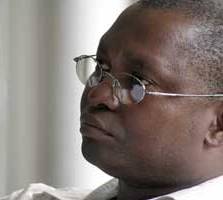 Ephraim Chirwa is an Associate Professor of Economics at Chancellor College,
Ephraim Chirwa is an Associate Professor of Economics at Chancellor College,